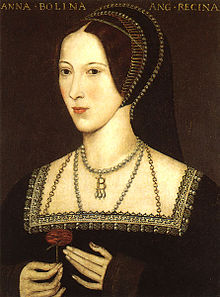 On this day in 1536, second wife of King Henry VIII and Marquess of Pembroke, Queen of England, Anne Boleyn was executed by beheading for high treason, adultery, incest and witchcraft, at the Tower of London. She was somewhere between 28 and 35 years old. Born in Norfolk at the Boleyn home at Blickling between 1501 and 1507. Henry’s marriage to Anne, and her subsequent execution, made her a key figure in the political and religious upheaval that was the start of the English Reformation. Anne was the daughter of Thomas Boleyn, 1st Earl of Wiltshire, and his wife, Lady Elizabeth Howard, and was educated in the Netherlands and France, largely as a maid of honour to Claude of France. She returned to England in early 1522, to marry her Irish cousin James Butler, 9th Earl of Ormond; the marriage plans ended in failure and she secured a post at court as maid of honour to Henry VIII’s wife, Catherine of Aragon. In February/March 1526, Henry VIII began his pursuit of Anne. She resisted his attempts to seduce her, refusing to become his mistress – which her sister Mary had been. It soon became the one absorbing object of Henry’s desires to annul his marriage to Queen Catherine so he would be free to marry Anne. When it became clear that Pope Clement VII would not annul the marriage, the breaking of the power of the Catholic Church in England began. In 1532, Henry granted her the Marquessate of Pembroke. Henry and Anne married on 25 January 1533. On 23 May 1533, Thomas Cranmer declared Henry and Catherine’s marriage null and void; five days later, he declared Henry and Anne’s marriage to be good and valid. Shortly afterwards, the Pope decreed sentences of excommunication against Henry and Cranmer. As a result of this marriage and these excommunications, the first break between the Church of England and Rome took place and the Church of England was brought under the King’s control. Anne was crowned Queen of England on 1 June 1533. On 7 September, she gave birth to the future Queen Elizabeth I, whose gender disappointed Henry. He was not entirely discouraged, for he said that a son would surely follow and professed to love Elizabeth. Three miscarriages followed, and by March 1536, Henry was courting Jane Seymour. Henry had Anne investigated for high treason in April 1536. On 2 May she was arrested and sent to the Tower of London, where she was tried before a jury of peers – which included Henry Percy, her former betrothed, and her own uncle, Thomas Howard – and found guilty on 15 May. She was beheaded four days later. Modern historians view the charges against her as unconvincing. Henry commuted Anne’s sentence from burning to beheading, and rather than have a queen beheaded with the common axe, he brought an expert swordsman from Saint-Omer in France, to perform the execution. Shortly before dawn, she heard mass and swore on the eternal salvation of her soul, upon the Holy Sacraments, that she had never been unfaithful to the king. She ritually repeated this oath both immediately before and after receiving the sacrament of the Eucharist. She wore a red petticoat under a loose, dark grey gown of damask trimmed in fur and a mantle of ermine. Accompanied by two female attendants, Anne made her final walk from the Queen’s House to the scaffold. Anne climbed the scaffold and made a short speech to the crowd:
On this day in 1536, second wife of King Henry VIII and Marquess of Pembroke, Queen of England, Anne Boleyn was executed by beheading for high treason, adultery, incest and witchcraft, at the Tower of London. She was somewhere between 28 and 35 years old. Born in Norfolk at the Boleyn home at Blickling between 1501 and 1507. Henry’s marriage to Anne, and her subsequent execution, made her a key figure in the political and religious upheaval that was the start of the English Reformation. Anne was the daughter of Thomas Boleyn, 1st Earl of Wiltshire, and his wife, Lady Elizabeth Howard, and was educated in the Netherlands and France, largely as a maid of honour to Claude of France. She returned to England in early 1522, to marry her Irish cousin James Butler, 9th Earl of Ormond; the marriage plans ended in failure and she secured a post at court as maid of honour to Henry VIII’s wife, Catherine of Aragon. In February/March 1526, Henry VIII began his pursuit of Anne. She resisted his attempts to seduce her, refusing to become his mistress – which her sister Mary had been. It soon became the one absorbing object of Henry’s desires to annul his marriage to Queen Catherine so he would be free to marry Anne. When it became clear that Pope Clement VII would not annul the marriage, the breaking of the power of the Catholic Church in England began. In 1532, Henry granted her the Marquessate of Pembroke. Henry and Anne married on 25 January 1533. On 23 May 1533, Thomas Cranmer declared Henry and Catherine’s marriage null and void; five days later, he declared Henry and Anne’s marriage to be good and valid. Shortly afterwards, the Pope decreed sentences of excommunication against Henry and Cranmer. As a result of this marriage and these excommunications, the first break between the Church of England and Rome took place and the Church of England was brought under the King’s control. Anne was crowned Queen of England on 1 June 1533. On 7 September, she gave birth to the future Queen Elizabeth I, whose gender disappointed Henry. He was not entirely discouraged, for he said that a son would surely follow and professed to love Elizabeth. Three miscarriages followed, and by March 1536, Henry was courting Jane Seymour. Henry had Anne investigated for high treason in April 1536. On 2 May she was arrested and sent to the Tower of London, where she was tried before a jury of peers – which included Henry Percy, her former betrothed, and her own uncle, Thomas Howard – and found guilty on 15 May. She was beheaded four days later. Modern historians view the charges against her as unconvincing. Henry commuted Anne’s sentence from burning to beheading, and rather than have a queen beheaded with the common axe, he brought an expert swordsman from Saint-Omer in France, to perform the execution. Shortly before dawn, she heard mass and swore on the eternal salvation of her soul, upon the Holy Sacraments, that she had never been unfaithful to the king. She ritually repeated this oath both immediately before and after receiving the sacrament of the Eucharist. She wore a red petticoat under a loose, dark grey gown of damask trimmed in fur and a mantle of ermine. Accompanied by two female attendants, Anne made her final walk from the Queen’s House to the scaffold. Anne climbed the scaffold and made a short speech to the crowd:
Good Christian people, I am come hither to die, for according to the law, and by the law I am judged to die, and therefore I will speak nothing against it. I am come hither to accuse no man, nor to speak anything of that, whereof I am accused and condemned to die, but I pray God save the king and send him long to reign over you, for a gentler nor a more merciful prince was there never: and to me he was ever a good, a gentle and sovereign lord. And if any person will meddle of my cause, I require them to judge the best. And thus I take my leave of the world and of you all, and I heartily desire you all to pray for me. O Lord have mercy on me, to God I commend my soul.
In a 1,318 line poem, written in French, two weeks after Anne’s death, Lancelot de Carle provides a moving account of her last words and their effect on the crowd:
She gracefully addressed the people from the scaffold with a voice somewhat overcome by weakness, but which gathered strength as she went on. She begged her hearers to forgive her if she had not used them all with becoming gentleness, and asked for their prayers. It was needless, she said, to relate why she was there, but she prayed the Judge of all the world to have compassion on those who had condemned her, and she begged them to pray for the King, in whom she had always found great kindness, fear of God, and love of his subjects. The spectators could not refrain from tears.
Lancelot de Carle, a secretary to the French Ambassador, Antoine de Castelnau, was in London in May 1536, and was an eyewitness to her trial and execution. The poem, Épistre Contenant le Procès Criminel Faict à l’Encontre de la Royne Anne Boullant d’Angleterre, (A Letter Containing the Criminal Charges Laid Against Queen Anne Boleyn of England), provides a detailed account of Anne’s early life and the circumstances relating to her arrest, trial and execution. It is thought that Anne avoided criticising Henry to save Elizabeth and her family from further consequences, but even under such extreme pressure Anne did not confess guilt, in fact subtly implying her innocence, in her appeal to historians who “will meddle of my cause”. The ermine mantle was removed and Anne lifted off her headdress, tucking her hair under a coif. After a brief farewell to her weeping ladies and a request for prayers, she kneeled down and one of her ladies tied a blindfold over her eyes. She knelt upright, in the French style of executions. Her final prayer consisted of her repeating continually, “Jesu receive my soul; O Lord God have pity on my soul.”
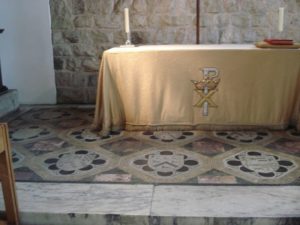 The Final Footprint – The execution consisted of a single stroke. She was then buried in an unmarked grave in the Chapel of St Peter ad Vincula. Her skeleton was identified during renovations of the chapel in 1876 and Anne’s resting place is now marked in the marble floor. Following the coronation of her daughter, Elizabeth, as queen, Anne was venerated as a martyr and heroine of the English Reformation. Over the centuries, she has inspired or been mentioned in numerous artistic and cultural works. As a result, she has retained her hold on the popular imagination. Anne has been called “the most influential and important queen consort England has ever had”, since she provided the occasion for Henry VIII to annul his marriage to Catherine of Aragon, and declare his independence from Rome. Many legends and fantastic stories about Anne Boleyn have survived over the centuries. One is that she was secretly buried in Salle Church in Norfolk under a black slab near the tombs of her Boleyn ancestors. Her body was said to have rested in an Essex church on its journey to Norfolk. Another is that her heart, at her request, was buried in Erwarton (Arwarton) Church, Suffolk by her uncle Sir Philip Parker. In 18th-century Sicily, the peasants of the village of Nicolosi believed that Anne Boleyn, for having made Henry VIII a heretic, was condemned to burn for eternity inside Mount Etna. This legend was often told for the benefit of foreign travelers. A number of people have claimed to have seen Anne’s ghost at Hever Castle, Blickling Hall, Salle Church, Tower of London, and Marwell Hall. The most famous account of her reputed sighting has been described by paranormal researcher Hans Holzer. In 1864, Major General J.D. Dundas of the 60th Rifles regiment was quartered in the Tower of London. As he was looking out the window of his quarters, he noticed a guard below in the courtyard, in front of the lodgings where Anne had been imprisoned, behaving strangely. He appeared to challenge something, which to the General “looked like a whitish, female figure sliding towards the soldier”. The guard charged through the form with his bayonet, then fainted. Only the General’s testimony and corroboration at the court-martial saved the guard from a lengthy prison sentence for having fainted while on duty. In 1960, Canon W. S. Pakenham-Walsh, vicar of Sulgrave, Northamptonshire, reported having conversations with Anne. Other notable final footprints at the Chapel include: Lady Jane Grey, William Hastings, 1st Baron Hastings; Margaret, Countess of Salisbury, the last of the Plantagenet dynasty; Queen Catherine Howard, fifth wife of Henry VIII; Jane Boleyn, Viscountess Rochford; and Robert Devereux, 2nd Earl of Essex.
The Final Footprint – The execution consisted of a single stroke. She was then buried in an unmarked grave in the Chapel of St Peter ad Vincula. Her skeleton was identified during renovations of the chapel in 1876 and Anne’s resting place is now marked in the marble floor. Following the coronation of her daughter, Elizabeth, as queen, Anne was venerated as a martyr and heroine of the English Reformation. Over the centuries, she has inspired or been mentioned in numerous artistic and cultural works. As a result, she has retained her hold on the popular imagination. Anne has been called “the most influential and important queen consort England has ever had”, since she provided the occasion for Henry VIII to annul his marriage to Catherine of Aragon, and declare his independence from Rome. Many legends and fantastic stories about Anne Boleyn have survived over the centuries. One is that she was secretly buried in Salle Church in Norfolk under a black slab near the tombs of her Boleyn ancestors. Her body was said to have rested in an Essex church on its journey to Norfolk. Another is that her heart, at her request, was buried in Erwarton (Arwarton) Church, Suffolk by her uncle Sir Philip Parker. In 18th-century Sicily, the peasants of the village of Nicolosi believed that Anne Boleyn, for having made Henry VIII a heretic, was condemned to burn for eternity inside Mount Etna. This legend was often told for the benefit of foreign travelers. A number of people have claimed to have seen Anne’s ghost at Hever Castle, Blickling Hall, Salle Church, Tower of London, and Marwell Hall. The most famous account of her reputed sighting has been described by paranormal researcher Hans Holzer. In 1864, Major General J.D. Dundas of the 60th Rifles regiment was quartered in the Tower of London. As he was looking out the window of his quarters, he noticed a guard below in the courtyard, in front of the lodgings where Anne had been imprisoned, behaving strangely. He appeared to challenge something, which to the General “looked like a whitish, female figure sliding towards the soldier”. The guard charged through the form with his bayonet, then fainted. Only the General’s testimony and corroboration at the court-martial saved the guard from a lengthy prison sentence for having fainted while on duty. In 1960, Canon W. S. Pakenham-Walsh, vicar of Sulgrave, Northamptonshire, reported having conversations with Anne. Other notable final footprints at the Chapel include: Lady Jane Grey, William Hastings, 1st Baron Hastings; Margaret, Countess of Salisbury, the last of the Plantagenet dynasty; Queen Catherine Howard, fifth wife of Henry VIII; Jane Boleyn, Viscountess Rochford; and Robert Devereux, 2nd Earl of Essex.
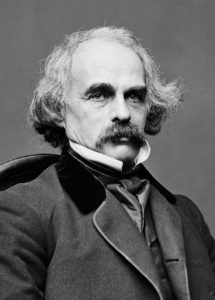 On this day in 1864, novelist, dark romantic, and short story writer Nathaniel Hawthorne died in his sleep in Plymouth, New Hampshire, at the age of 59. Born on July 4, 1804 in Salem, Massachusetts. His ancestors include John Hathorne, the only judge involved in the Salem witch trials who never repented of his actions. He entered Bowdoin College in 1821 and graduated in 1825. He published his first work in 1828, the novel Fanshawe; he later tried to suppress it, feeling that it was not equal to the standard of his later work. He published several short stories in periodicals, which he collected in 1837 as Twice-Told Tales. The next year, he became engaged to Sophia Peabody. He worked at the Boston Custom House and joined Brook Farm, a transcendentalist community, before marrying Peabody in 1842. The couple moved to The Old Manse in Concord, Massachusetts, later moving to Salem, the Berkshires, then to The Wayside in Concord. The Scarlet Letter was published in 1850, followed by a succession of other novels. A political appointment as consul took Hawthorne and family to Europe before their return to Concord in 1860.
On this day in 1864, novelist, dark romantic, and short story writer Nathaniel Hawthorne died in his sleep in Plymouth, New Hampshire, at the age of 59. Born on July 4, 1804 in Salem, Massachusetts. His ancestors include John Hathorne, the only judge involved in the Salem witch trials who never repented of his actions. He entered Bowdoin College in 1821 and graduated in 1825. He published his first work in 1828, the novel Fanshawe; he later tried to suppress it, feeling that it was not equal to the standard of his later work. He published several short stories in periodicals, which he collected in 1837 as Twice-Told Tales. The next year, he became engaged to Sophia Peabody. He worked at the Boston Custom House and joined Brook Farm, a transcendentalist community, before marrying Peabody in 1842. The couple moved to The Old Manse in Concord, Massachusetts, later moving to Salem, the Berkshires, then to The Wayside in Concord. The Scarlet Letter was published in 1850, followed by a succession of other novels. A political appointment as consul took Hawthorne and family to Europe before their return to Concord in 1860.
Much of Hawthorne’s writing centers on New England, many works featuring moral metaphors with an anti-Puritan inspiration. His fiction works are considered part of the Romantic movement and, more specifically, dark romanticism. His themes often center on the inherent evil and sin of humanity, and his works often have moral messages and psychological complexity. His published works include novels, short stories, and a biography of his college friend Franklin Pierce, the 14th President of the United States.
The Final Footprint

Henry Wadsworth Longfellow wrote a tribute poem to Hawthorne published in 1866 called “The Bells of Lynn”. Hawthorne was buried on what is now known as “Authors’ Ridge” in Sleepy Hollow Cemetery, Concord, Massachusetts. Pallbearers included Longfellow, Ralph Waldo Emerson, Bronson Alcott, Oliver Wendell Holmes Sr., James Thomas Fields, and Edwin Percy Whipple. Emerson wrote of the funeral: “I thought there was a tragic element in the event, that might be more fully rendered—in the painful solitude of the man, which, I suppose, could no longer be endured, & he died of it.” His wife Sophia and daughter Una were originally buried in England. However, in June 2006, they were reinterred in plots adjacent to Hawthorne. Other notable final footprints at Sleepy Hollow include; Louisa May Alcott, Ralph Waldo Emerson and Henry David Thoreau.
#RIP #OTD in 1895 Cuban nationalist, poet, philosopher, essayist, journalist, translator, professor, publisher, Cuban national hero, José Martí died during the Battle of Dos Ríos, Cuba, aged 42. Cementerio Santa Ifigenia, Santiago de Cuba
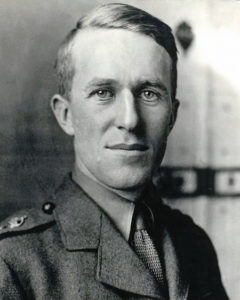 On this day in 1935, archaeologist, army officer, diplomat, and writer T. E. Lawrence died from injuries in a motorcycle crash in Dorset close to his cottage Clouds Hill, near Wareham, England, at the age of 46 . Born Thomas Edward Lawrence on 16 August 1888 in Tremadog, Carnarvonshire, Wales. He was renowned for his liaison role during the Sinai and Palestine Campaign and the Arab Revolt against the Ottoman Empire during the First World War. The breadth and variety of his activities and associations, and his ability to describe them vividly in writing, earned him international fame as Lawrence of Arabia—a title used for the 1962 film based on his wartime activities.
On this day in 1935, archaeologist, army officer, diplomat, and writer T. E. Lawrence died from injuries in a motorcycle crash in Dorset close to his cottage Clouds Hill, near Wareham, England, at the age of 46 . Born Thomas Edward Lawrence on 16 August 1888 in Tremadog, Carnarvonshire, Wales. He was renowned for his liaison role during the Sinai and Palestine Campaign and the Arab Revolt against the Ottoman Empire during the First World War. The breadth and variety of his activities and associations, and his ability to describe them vividly in writing, earned him international fame as Lawrence of Arabia—a title used for the 1962 film based on his wartime activities.
Soon after the outbreak of war, he volunteered for the British Army and was stationed in Egypt. In 1916, he was sent to Arabia on an intelligence mission and quickly became involved with the Arab Revolt as a liaison to the Arab forces, along with other British officers. He worked closely with Emir Faisal, a leader of the revolt, and he participated in and sometimes led military activities against the Ottoman armed forces, culminating in the capture of Damascus in October 1918.
After the war, Lawrence joined the Foreign Office, working with the British government and with Faisal. In 1922, he retreated from public life and spent the years until 1935 serving as an enlisted man, mostly in the Royal Air Force, with a brief stint in the Army. During this time, he published his best-known work Seven Pillars of Wisdom, an autobiographical account of his participation in the Arab Revolt. He also translated books into English and wrote The Mint, which was published posthumously and detailed his time in the Royal Air Force working as an ordinary aircraftman. He corresponded extensively and was friendly with well-known artists, writers, and politicians. For the Royal Air Force, he participated in the development of rescue motorboats.
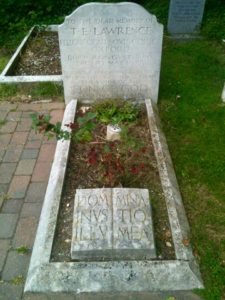 The Final Footprint
The Final Footprint

Memorial near the crash site which is found south of his cottage at Clouds Hill, Wareham, Dorset
He is interred in the separate burial ground of St Nicholas’ Church, Moreton. Mourners included Winston, E. M. Forster, Lady Astor, and Lawrence’s youngest brother Arnold.
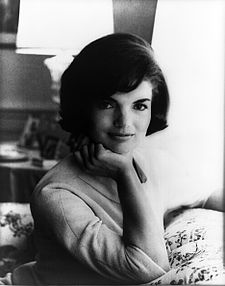 On this day in 1994, wife of the 35th President of the United States, First Lady of the United States, fashion icon, editor, Jackie, Jacqueline Kennedy Onassis died in her sleep from cancer at her apartment in New York City at the age of 64. Born Jacqueline Lee Bouvier on 28 July 1929 in Southampton, New York. She is remembered for her contributions to the arts and preservation of historic architecture, her style, elegance and grace.
On this day in 1994, wife of the 35th President of the United States, First Lady of the United States, fashion icon, editor, Jackie, Jacqueline Kennedy Onassis died in her sleep from cancer at her apartment in New York City at the age of 64. Born Jacqueline Lee Bouvier on 28 July 1929 in Southampton, New York. She is remembered for her contributions to the arts and preservation of historic architecture, her style, elegance and grace.
Jackie married John F. Kennedy on 12 September 1953. They had four children; Arabella (23 August 1956 – 23 August 1956), Caroline Bouvier (27 November 1957 – ), John Fitzgerald Jr. (25 November 1960 – 16 July 1999), and Patrick Bouvier (7 August 1963 – 9 August 1963). Jackie proved to be a very popular First Lady. When the Kennedys visited France, Jackie so impressed the public that President Kennedy remarked; “I am the man who accompanied Jacqueline Kennedy to Paris — and I have enjoyed it!” Jackie’s steadiness and courage during and after JFK’s assassination and funeral won her admiration around the world. Lady Jeanne Campbell reported back to The London Evening Standard: “Jacqueline Kennedy has given the American people… one thing they have always lacked: Majesty.” During an interview with Theodore H. White of Life magazine she compared the Kennedy years in the White House to King Arthur’s mythical Camelot, commenting that the President often played the title song of Lerner and Loewe‘s musical recording before retiring to bed. She also quoted Queen Guinevere from the musical, trying to express how the loss felt. Following Robert F. Kennedy’s assassination on 6 June 1968, Jackie apparently began to fear for the safety of her children. Perhaps this was a factor in her decision to marry Greek shipping magnate Aristotle Onassis; seeking the privacy and protection his vast wealth provided. They married on 20 October 1968 on his private island Skorpios in the Ionian Sea.
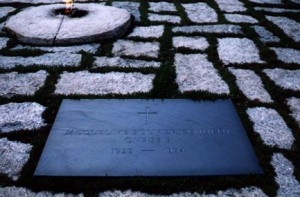 The Final Footprint – Jackie is interred next to JFK in Arlington National Cemetery. Her grave is marked by a flat granite engraved marker that matches her husband’s. Jackie’s legacy has been memorialized in various aspects of American culture and she is frequently alluded to and depicted in various forms of popular culture, including books, films, television series, cartoon series, video games and music. Other notable Final Footprints at Arlington include; Space Shuttle Challenger, Space Shuttle Columbia, Medgar Evers, Dashiell Hammett, JFK, RFK, Edward Kennedy, Malcolm Kilduff, Jr., Lee Marvin, and Audie Murphy.
The Final Footprint – Jackie is interred next to JFK in Arlington National Cemetery. Her grave is marked by a flat granite engraved marker that matches her husband’s. Jackie’s legacy has been memorialized in various aspects of American culture and she is frequently alluded to and depicted in various forms of popular culture, including books, films, television series, cartoon series, video games and music. Other notable Final Footprints at Arlington include; Space Shuttle Challenger, Space Shuttle Columbia, Medgar Evers, Dashiell Hammett, JFK, RFK, Edward Kennedy, Malcolm Kilduff, Jr., Lee Marvin, and Audie Murphy.
Have you planned yours yet?
Follow TFF on twitter @RIPTFF


Pingback: Calculate your carbon footprint | Autism symptoms Blog